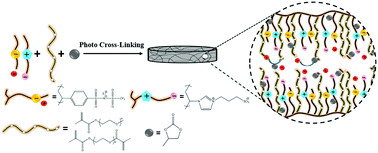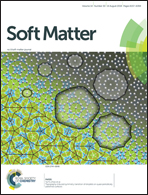Single lithium-ion polymer electrolytes based on poly(ionic liquid)s for lithium-ion batteries†
Abstract
A promising method of synthesizing a lithium-containing room temperature polymeric ionic liquid (PIL) by utilizing the zwitterionic effect to turn a lithium salt into a liquid for single lithium-ion conduction was proposed. In this work, the room temperature PIL was constructed by the equimolar monomer mixture of zwitterion 3-(1-vinyl-3-imidazolic)propanesulfonate (VIPS) and 4-styrenesulfnny(trifluoromethylsulfony)imde (LiSTFSI) based on intermolecular electrostatic interactions. In situ photopolymerization with flexible chain poly(ethylene glycol)methyl ether methacrylate (PEGM) and cross-linker poly(ethylene glycol)dimethacrylate (PEGDM) in the presence of propylene carbonate (PC) generated free-standing PIL electrolyte films. The PIL electrolytes with Li+-rich channels have an excellent lithium transference number approaching unity (0.93 at room temperature) while attaining comparable ionic conductivity (σ ≈ 1.31 × 10−4 S cm−1 at 30 °C). The charge–discharge performance of a Li/LiFePO4 half-cell equipped with this PIL electrolyte would provide a promising model system for novel single lithium ion conductors.



 Please wait while we load your content...
Please wait while we load your content...